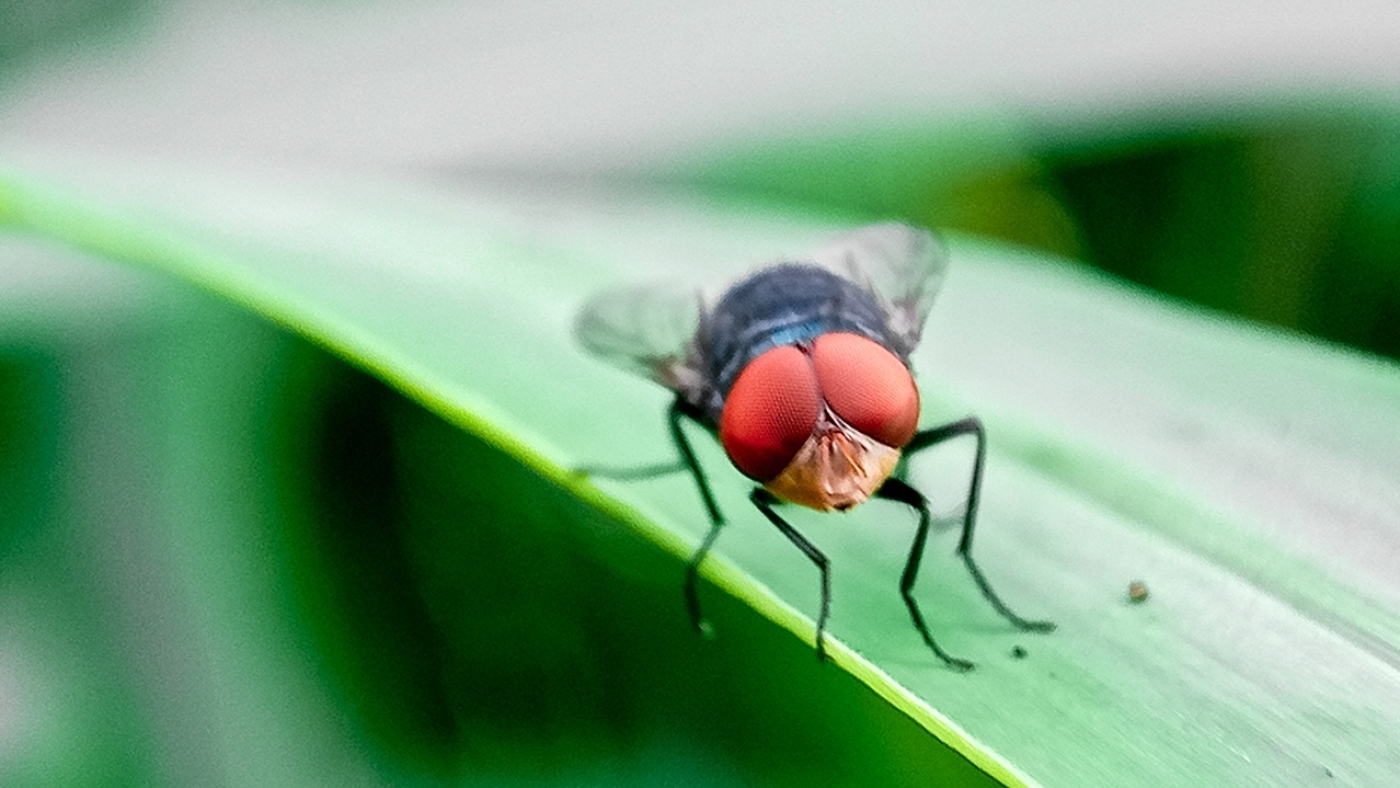“A shocking crisis has emerged at the U.S.-Mexico border, where a sinister threat to public health has prompted the U.S. government to take drastic action. As of yesterday, the country has temporarily halted all cattle imports from Mexico, sparking widespread concern and confusion among the livestock industry and food producers. The abrupt move is in response to a disturbing issue that has left experts and regulators reeling: the presence of a flesh-eating maggot infestation in Mexican cattle, which poses a significant risk to the nation’s beef supply. In this article, we’ll explore the reasons behind this sudden decision and what it means for the future of U.S. agriculture.”
U.S. Halts Cattle Imports from Mexico Due to Flesh-Eating Maggot Concerns

The United States has temporarily halted all imports of live cattle, horses, and bison from Mexico due to growing concerns over a flesh-eating maggot parasite known as the New World screwworm. This decision was made by Agriculture Secretary Brooke Rollins, citing the northward spread of the parasite in southern Mexico over the past year.
According to the U.S. Department of Agriculture (USDA), the New World screwworm is a fly larva that burrows into wounds or mucous membranes of animals, feeding on their flesh and blood. If left untreated, the parasitic infection can be fatal to a full-grown cow within one to two weeks.

The New Threat: New World Screwworms
Rising Cases in Central America and Mexico
Rising cases of New World screwworms have been reported in parts of Central America, and the parasite has been detected in remote farms in Mexico, approximately 700 miles from the U.S. border. This surge in cases has raised concerns among agricultural officials, who fear that the parasite could spread to the United States if left unchecked.
- According to the USDA, cases of New World screwworms have increased in Central America over the past few years.
- The parasite has been detected in southern Mexico, with reports of cases in remote farms near the U.S. border.
The Alarming Consequences of Infection

Left untreated, New World screwworm infections can have devastating consequences for animals. In addition to being fatal, the parasite can also cause significant economic losses for farmers and ranchers.
According to the USDA, an outbreak of New World screwworms in Texas in 1976 affected over 1.4 million cattle and hundreds of thousands of sheep and goats, resulting in estimated losses of $1.8 billion.

Historical Efforts to Eradicate the Pest
The U.S. and Mexico have a long history of working together to eradicate the New World screwworm. In the 1960s and 1970s, the two countries released hundreds of millions of sterile adult flies to mate with female New World screwworms, preventing them from laying viable eggs.
This strategy helped create a “barrier zone” that kept the parasite from encroaching into the U.S. and Mexico, although cases would still occasionally arise.
Why the U.S. is Taking Action
Agricultural Officials’ Concerns and Justifications
Agricultural officials have expressed concerns over the spread of New World screwworms, citing the potential economic and animal health consequences of an outbreak.
“The protection of our animals and safety of our nation’s food supply is a national security issue of the utmost importance,” said Agriculture Secretary Brooke Rollins in a statement.
“This is not about politics or punishment of Mexico, rather it is about food and animal safety,” she added.
The Potential Economic Fallout of an Outbreak
An outbreak of New World screwworms could have significant economic consequences for the United States, particularly for farmers and ranchers in affected areas.
According to the USDA, a New World screwworm outbreak in Texas in 1976 resulted in estimated losses of $1.8 billion.
The Protection of the Nation’s Food Supply and Animal Safety
The U.S. has a long history of prioritizing animal health and food safety, and the decision to halt cattle imports from Mexico is a reflection of this commitment.
“The protection of our animals and safety of our nation’s food supply is a national security issue of the utmost importance,” said Agriculture Secretary Brooke Rollins.
The Implications of the Ban
Immediate Consequences
The ban on cattle imports from Mexico will have immediate consequences for farmers and ranchers who rely on these imports to meet their livestock needs.
According to the USDA, the ban will continue on a “month-by-month basis, until a significant window of containment is achieved.”
Long-term Consequences
The long-term consequences of the ban are still unclear, but it is likely to have significant economic and trade implications for both the U.S. and Mexico.
“This decision will have far-reaching consequences for the livestock industry and will require careful consideration and planning to mitigate any negative impacts,” said an industry expert.
Impact on U.S.-Mexico Trade Relations
The halt on cattle imports from Mexico has significant implications for the trade relations between the two countries. The move is expected to have a ripple effect on the economy, with potential losses running into millions of dollars. The decision has been taken to prevent the spread of the New World screwworm, a flesh-eating parasite that has been detected in southern Mexico in the last year.
The U.S. Department of Agriculture has expressed concerns over the northward spread of the New World screwworm, and has taken this decision as a precautionary measure. “The protection of our animals and safety of our nation’s food supply is a national security issue of the utmost importance,” said Agriculture Secretary Brooke Rollins in a statement.
The Economic Consequences for U.S. Cattle Farmers
The economic consequences of this decision will be felt by U.S. cattle farmers, who rely heavily on imports from the country. The ban on live animal trade on the border in November was lifted in February after the U.S. and Mexico agreed on new measures to keep the parasite at bay. However, the new ban will continue on a “month-by-month basis, until a significant window of containment is achieved,” according to the USDA.
The potential fallout is significant, with an outbreak in Texas alone estimated to cost the state’s economy $1.8 billion, according to a USDA analysis. This has alarming implications for the cattle farmers, who will have to bear the brunt of the economic losses.
Potential Long-Term Solutions and Containment Measures
In the long term, the solution to this problem lies in finding a sustainable way to contain the spread of the New World screwworm. This can be achieved through a combination of measures, including the release of sterile adult flies that would mate with the females, ultimately preventing them from laying viable eggs.
This strategy has been successful in the past, with the U.S and Mexico able to eradicate the New World screwworm in the 1960s and 1970s. The creation of a “barrier zone” that kept the pest from encroaching into the U.S. and Mexico, though cases would still pop up from time to time.
Agricultural History and Lessons Learned
The 1960s and 1970s Eradication Efforts
The 1960s and 1970s saw a concerted effort by the U.S. and Mexico to eradicate the New World screwworm. This was achieved through the release of hundreds of millions of sterile adult flies that would mate with the females, ultimately preventing them from laying viable eggs.
This strategy was successful, and the New World screwworm was eradicated in the U.S. and Mexico. However, cases would still pop up from time to time, highlighting the need for continued vigilance and cooperation.
The 1976 Texas Outbreak: A Cautionary Tale
In 1976, an outbreak in Texas affected more than 1.4 million cattle and hundreds of thousands of sheep and goats. This outbreak had significant economic implications, with the need for continued vigilance and cooperation to prevent such outbreaks in the future.
The 1976 outbreak highlights the potential fallout of an outbreak, and the need for continued efforts to prevent such outbreaks in the future. This is why agricultural officials are so alarmed that the pest has made a comeback in the last few years.
The Need for Continued Vigilance and Cooperation
The need for continued vigilance and cooperation is highlighted by the recent outbreak of the New World screwworm in Mexico. The outbreak has significant implications for the economy, and highlights the need for continued efforts to prevent such outbreaks in the future.
This can be achieved through a combination of measures, including the release of sterile adult flies that would mate with the females, ultimately preventing them from laying viable eggs. This strategy has been successful in the past, and can be successful again with continued cooperation and vigilance.
The Future of Cattle Imports and Animal Health
U.S. and Mexico’s New Measures to Contain the Pest
The U.S. and Mexico have agreed on new measures to contain the New World screwworm. This includes the release of sterile adult flies that would mate with the females, ultimately preventing them from laying viable eggs.
This strategy has been successful in the past, and can be successful again with continued cooperation and vigilance. The creation of a “barrier zone” that kept the pest from encroaching into the U.S. and Mexico, though cases would still pop up from time to time.
The Ongoing Efforts to Prevent a Full-Blown Outbreak
The ongoing efforts to prevent a full-blown outbreak are crucial to preventing economic losses and protecting animal health. This can be achieved through a combination of measures, including the release of sterile adult flies that would mate with the females, ultimately preventing them from laying viable eggs.
This strategy has been successful in the past, and can be successful again with continued cooperation and vigilance. The creation of a “barrier zone” that kept the pest from encroaching into the U.S. and Mexico, though cases would still pop up from time to time.
The Role of Science and Technology in Combatting the New World Screwworm
The role of science and technology is crucial in combatting the New World screwworm. This includes the development of new technologies that can help prevent the spread of the pest, as well as the development of new strategies to contain the pest.
This can be achieved through a combination of measures, including the release of sterile adult flies that would mate with the females, ultimately preventing them from laying viable eggs. This strategy has been successful in the past, and can be successful again with continued cooperation and vigilance.
Conclusion
In conclusion, the U.S. Department of Agriculture’s decision to halt cattle imports from Mexico has sparked controversy and raised concerns about the flesh-eating maggot, known as screwworms. The article has highlighted the devastating impact of these parasites on livestock, resulting in significant economic losses for farmers and ranchers. Moreover, the article has also emphasized the potential risks to human health, as screwworms can infect open wounds, leading to serious health complications.
The implications of this situation extend beyond the agricultural sector, and have far-reaching consequences for public health, trade, and diplomacy. The U.S. government’s decision to halt cattle imports from Mexico has significant trade implications, potentially disrupting the flow of goods and services between the two countries. Furthermore, the failure to address this issue effectively could lead to the spread of screwworms to other regions, posing a significant threat to global food security.
As we move forward, it is essential that policymakers, agricultural experts, and health professionals work together to develop effective strategies to combat the spread of screwworms. This requires a concerted effort to improve surveillance, detection, and eradication methods, as well as enhance international cooperation to prevent the spread of this parasite. Ultimately, the ability to effectively address this issue will depend on our capacity to prioritize public health, animal welfare, and economic stability above political and ideological differences. As we stand at the crossroads of this crisis, it is imperative that we recognize that the fate of our food systems, economies, and ultimately, our health, hangs precariously in the balance.
